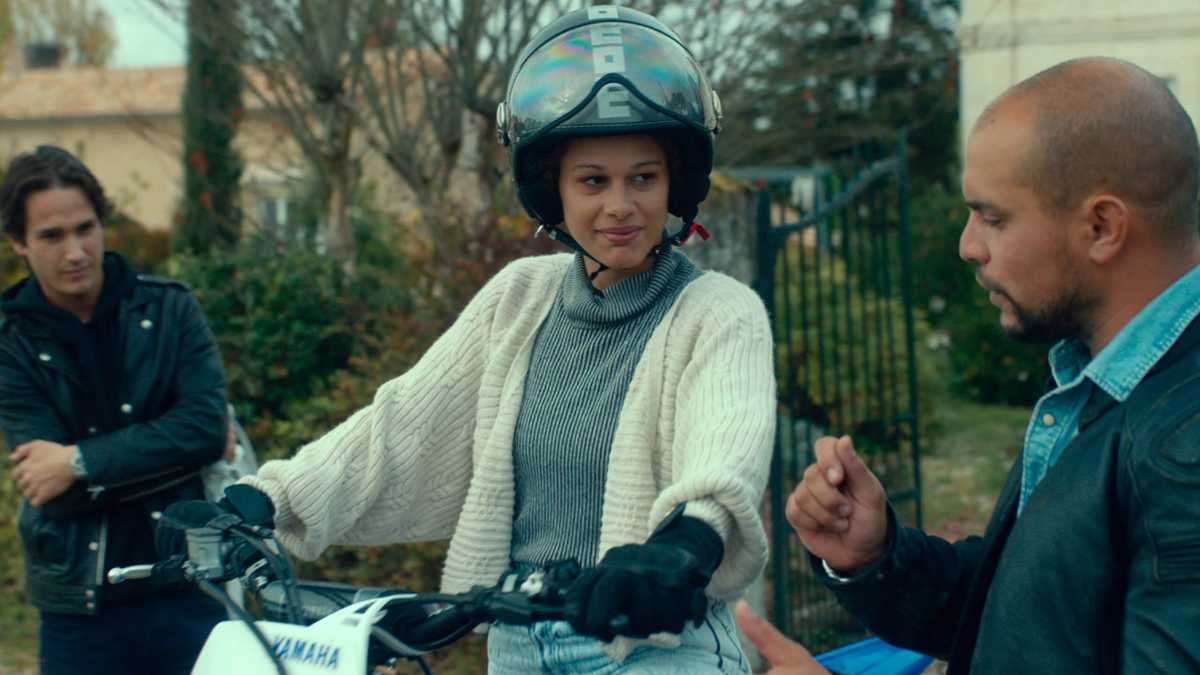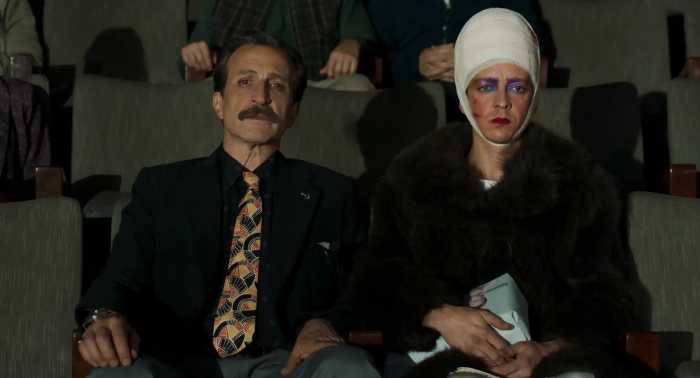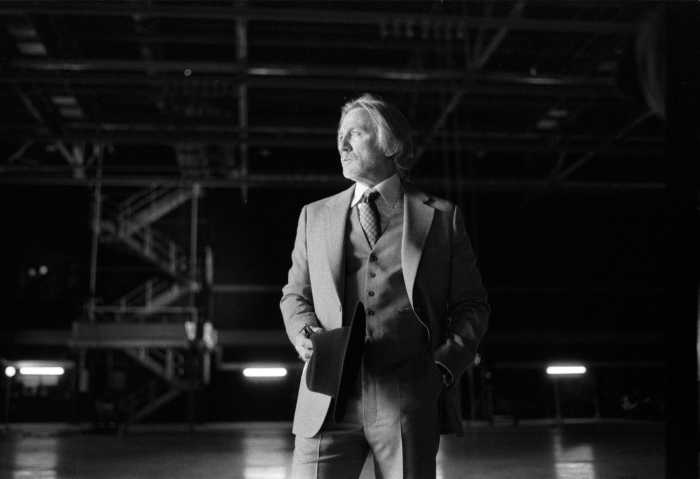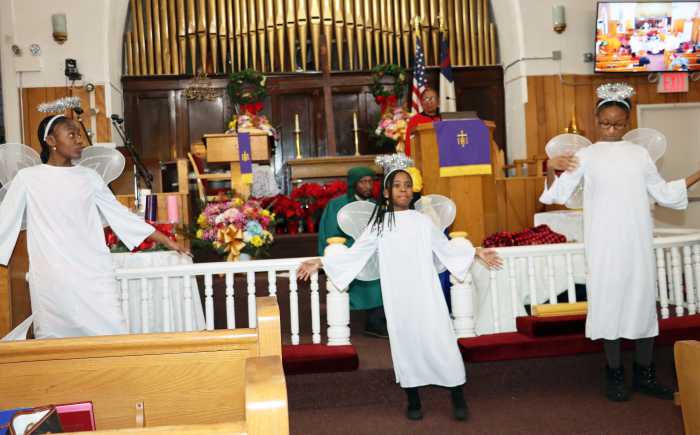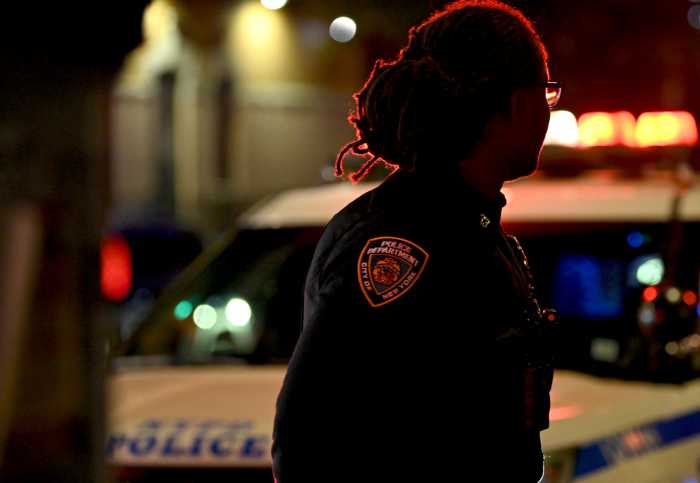Julia (Julie Ledru) wants only to ride motorbikes, and she gets them by conning folks who sell them into letting her hold her purse as she takes a test ride — often flipping them the bird as she trails off laughing in a cloud of exhaust. Out queer director/cowriter Lola Quivoron makes an auspicious feature debut as “Rodeo” chronicles Julia’s involvement with a male gang of dirt riders that are led by Domino (Sébastian Schroeder), who is doing a stretch in prison.
Julia steals bikes for Domino to resell, which gets her some credibility with Kaïs (Yannis Lafki), and she ingratiates herself with Ophélie (Antonia Buresi), the mother of Domino’s son. But Julia’s aggressive behavior — borrowing or taking anything and everything she can — does not endear her to everyone. Quivoron shows how Julia gets by in this male-dominated world. And viewers can practically smell the gasoline as the characters rev their engines.
The filmmaker chatted with Gay City News about making “Rodeo.”
What research did you do to tell this story about this community?
I spent seven years as part of the dirt riders community based in the suburbs of Paris. I wanted the film to be close to the energy I observed. One of the beautiful things I discovered was how people were gathering around this space. It created solidarity.
Julia, as well as Ophélie, are trapped, and riding provides them with an escape. All the characters seem trapped by race, class, gender or environment. Can you talk about this motif in your film?
It’s my vision of the world. It’s difficult to create a safe space without any domination. I wanted to put this motif of domination in perspective. One important thing was the fact that Julia is a female who is rejected because her body is a problem; if she were male, she’d be accepted. All the characters are trapped, but they also try to escape and find a way to be in a safe space and be free. Riding is a metaphor — a way to be free, escape. The speed provides a way to break out of this space and not be caught. Ophélie and her son are also trapped, but their relationship in the film is important because Julia needs to find this little family. I see Julia as a female character as a soldier who fights against things, but wants to be accepted for who she is.
Your film immerses viewers in this very specific world. Can you talk about developing the community and building a narrative out of this milieu?
I wanted a special intensity. We improvised to create this energy. We tried to always be in motion. Movement was important. We tried to catch Julia, even if she wants to escape all the time. We did that with close ups. I wanted the film to be like an urban western, so we used the cinemascope format and colors with a lot of contrast and brightness and grains to break from the documentary style. It’s a real world, but it’s fictional. The guys who play the men in the community are non-professionals, so we worked with them before shooting on improvisation and physical exercises to put them inside this world.
What decisions did you make about developing Julia’s character? She can be unlikable. She is very determined. She is looking for a sense of belonging but has some issues with boundaries. She is self-reliant but often must rely on others. How did you conceive of her?
It was important to construct a mystery about her and depict the strong energy of her character. I wanted the spectator to expect things and to be surprised all the time. In a way, Julia is queer, because she doesn’t belong to a standard representation of how to be in society. She’s an outcast and set apart. She’s a kind of “freak,” but I don’t like this term; I prefer queer. She has this special view of the world, and she rebels all the time from what we can expect from a girl. She is a girl, but she acts like she is in between the gender binary, between dreams and reality, and between death and life. She follows this specific lifeline which is really vertiginous. Sometimes we like her, sometimes we hate her, and sometimes we don’t understand all her actions, but afterwards, we can. I wanted her to be like a soldier who receives punches, but she can also defend herself and punch others. I wanted her to represent feminine violence and the anger inside and the expressions of that. She has this volcanic violence. It’s spectacular sometimes. It’s rare to have this female. She could be beautiful and ugly at same time. She’s multifaceted.
The film has a style that is both gritty and dreamy. Can you talk about your visual approach to the film?
I don’t like naturalistic films. In France and in Europe, we were fed by that aesthetic after the Nouvelle Vague, and in the 1990s, everyone shot films with this naturalistic approach to show reality as it is without any aesthetic distortion. I wanted an artificial construction. I wanted a lot of closeups because that emphasizes reality. We don’t face people like that. It’s special to cinema. Closeups are a way to observe the world in an artificial position. I wanted the film to be colorful, and have movement, and play with genre. You can follow the surreal moments with the dream sequences. We are in between. We are not in reality, but in this distorted perception of reality. I wanted the film to go beyond reality.
What can you say about filming the biking scenes, and the stunts?
It was really dangerous, and we had several accidents. It was stressful. We worked with an amazing pro stunt team. I told them I wanted a lot of security, but I wanted the riders to be free as they are in real life, so we used those limits to create this safe space. We used a Polaris, which was a kind of buggy, so we were free to move during the riding sequences. And we worked with a motorbike, mostly for the robbery sequences. We used those techniques to be close to the energy of the practice and receive the adrenaline as well.
What can you say about being a queer filmmaker?
I consider myself a queer, lesbian, non-binary filmmaker. It’s my way to be — not an activist, but a way to fight for transfeminist issues. It is important to speak out and not hide myself. My film is feminist, but, like everywhere, it is a male-dominated industry, and difficult to not speak out but to be listened to. It’s always something I have in mind, and I think about it every second of being a filmmaker: How can we change the rules of the game? We are not paid the same as a male director, and we have less money to expose the film in the distribution. When a woman is making an action movie, there is always this perception that people don’t believe this woman will do an action film. It’s always a goal that I can make an action film, or a war film. I like to do what people don’t expect.
“Rodeo” | Directed by Lola Quivoron | Screening March 16 at MoMI’s First Look Festival and opening March 17 at the Angelika Film Center | Distributed by Music Box Films.

